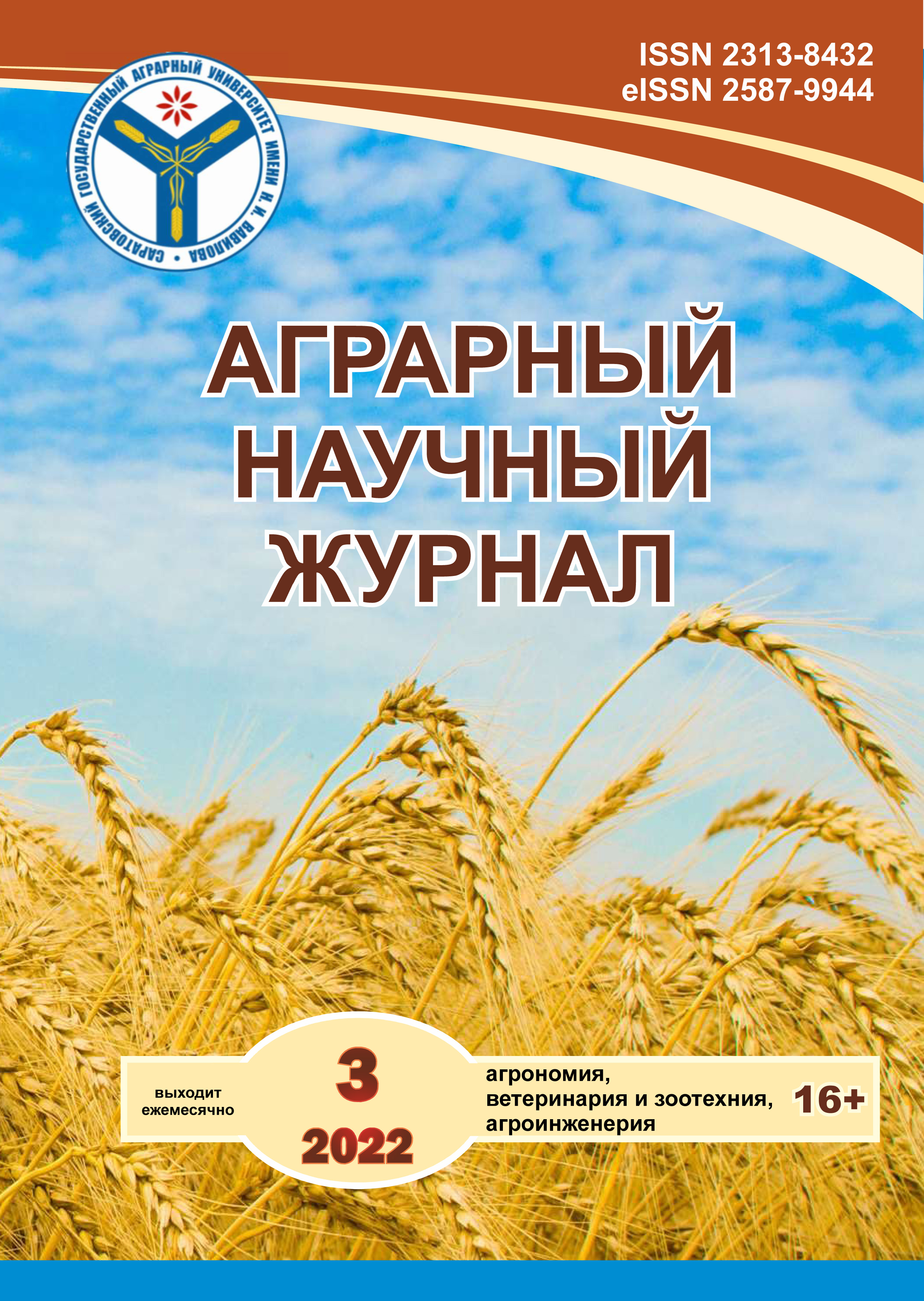Features of the production process of soybean varieties from different regions of zoning in the agro-climatic conditions of the Non-Chernozem Zone of the Russian Federation
DOI:
https://doi.org/10.28983/asj.y2022i3pp4-9Keywords:
Glycine max (L.) Merr., varieties, production process, Central Non-Chernozem region;, agro-climatic conditionsAbstract
The aim of the study was to analyze the changes in the dynamic parameters of the development of sowing of early-ripening soybean varieties from different regions of origin – the northern ecotype, southern and Far Eastern in the conditions of the CRNZ of the Russian Federation with sufficient moisture supply of the growing season and in arid conditions. The results of the study. The maximum values of dry biomass in all groups of varieties reached by the end of the bean growth period, which corresponds to phases R5–R6 (the beginning of seed filling – full filling of seeds) and averaged 3400–5700 kg/ha for varieties, this value varied from 3400 kg/ha for varieties of the northern Orca ecotype in arid conditions of the growing season to 5700 kg/ha for the southern Avanta variety in conditions of sufficient moisture. In the extremely dry 2010 the maximum values of dry biomass were reached by the R4 phase – made beans, there was no further increase, the maximum dry biomass decreased by 2 times compared to the growing seasons with sufficient moisture, and ranged from 3250 kg/ha for soybean varieties of the northern ecotype, to 3400 kg/ha for Far Eastern varieties. As a result of the analysis of the production process of soybean varieties of different regions of origin in different conditions of the temperature and humidity regime of the growing season, it was found that the southern early-ripening varieties correspond to the possible variability of the moisture regime of the growing season in the CRNZ of the Russian Federation to a greater extent than the Far Eastern varieties and, along with the varieties of the northern ecotype, can be recommended for cultivation in the conditions of the CRNZ of the Russian Federation. In acutely arid conditions (GTK < 1), there were no fundamental differences between the groups of varieties according to the peculiarities of the production process, all of them formed dry biomass 2 times smaller than the conditions of sufficient moisture.
Downloads
References
Акатов П. В. Глобальное потепление и его региональные последствия для Европейской части России // Живые и биокосные системы. 2016. № 15. С. 14–22.
Белышкина М. Е., Кобозева Т. П., Гуреева Е. В. Рост и развитие сортов сои северного экотипа в зависимости от влияния лимитирующих факторов вегетационного периода // Аграрный научный журнал. 2020. № 9. С. 4–9.
Белышкина М. Е., Кобозева Т. П., Шевченко В. А., Делаев У. А. Влияние норм высева и способов посева на урожайность и качество семян раннеспелых сортов и форм сои северного экотипа // Известия Тимирязевской сельскохозяйственной академии. 2018. № 4. С. 182–190.
Григорьева Е. А., Нотов А. А. Изменение климата и динамика биоразнообразия: прогнозы для территории Европейской и Дальневосточной России // Вестник Тверского государственного университета. Серия: Биология и экология. 2018. № 3. С. 165–177.
Доклад об особенностях климата на территории Российской Федерации за 2020 год. М.: Росгидромет, 2021. 104 с.
Зеленцов С. В., Мошненко Е. В. Пути адаптации сельского хозяйства России к глобальным изменениям климата на примере экологической селекции сои // Научный диалог. Естествознание и экология. 2012. № 7. С. 40–59.
Иванов А. Л. Глобальное изменение климата и его влияние на сельское хозяйство России // Земледелие. 2009. № 1. С. 3–5.
Регистр ресурсов-энергосберегающих технологий производства продукции растениеводства для Рязанской области (Система технологий) / Под общ. ред. С. В. Сальникова. Рязань: Рязанский НИПТИ АПК Россельхозакадемии, 2007. С. 92–101.
Синеговская В. Т., Наумченко Е. Т., Кобозева Т. П. Методы исследований в полевых опытах с соей. Благовещенск: ФГБНУ «Всероссийский НИИ сои», 2016. 116 с.
Сихарулидзе Т. Д., Храмой В. К. Влияние температурного режима на продолжительность вегетационного периода и урожайность сои в условиях Центрального Нечерноземья // Известия Тимирязевской сельскохозяйственной академии. 2017. № 4. С. 32–39.
Специализированные массивы для климатических исследований: Информация ВНИИГМИ-МЦД [Электронный ресурс]. – Режим доступа: http:// aisori.meteo.ru/ClimateR.
Хайрулина Т. П., Тихончук П. В. Изменение продуктивности сои под действием температурного стрессора // Достижения науки и техники АПК. 2012. № 2. С. 48–49.
Djanaguiraman M., Prasad P.V., Schapaugh W. T., Boyle D. L. High-temperature stress and soybean leaves: leaf anatomy and photosynthesis // Crop Science. 2011. Vol. 51. No. 5. Рр. 2125–2131.
Egli D. B. Soybean reproductive sink size and short-term reductions in photosynthesis during flowering and pod set // Crop Science. 2010. Vol. 50. Р. 1971–1977.
Jumrani K., Bhatia V. S. Interactive effect of temperature and water stress on physiological and biochemical processes in soybean // Physiology and Molecular Biology of Plants. 2019. Vol. 25. No. 3. Р. 667–681.
Nguy-Robertson A., Suyker A., Xiao X. Modeling gross primary production of maize and soybean croplands using light quality, temperature, water stress, and phenology // Agricultural and Forest Meteorology. 2015. Vol. 213. Р. 160–172.
Downloads
Published
Issue
Section
License
Copyright (c) 2022 The Agrarian Scientific Journal

This work is licensed under a Creative Commons Attribution-NonCommercial 4.0 International License.








